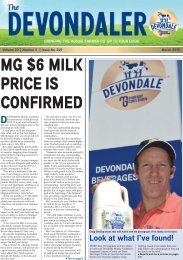Create successful ePaper yourself
Turn your PDF publications into a flip-book with our unique Google optimized e-Paper software.
12<br />
JUNE <strong>2015</strong><br />
DEVONDALE MURRAY GOULBURN<br />
Maximise pasture growth this winter<br />
NITROGEN is an essential<br />
nutrient important for<br />
plant growth.<br />
It assists chlorophyll production,<br />
which gives a plant its dark<br />
green colour.<br />
A lack of nitrogen usually<br />
results in yellowing of the<br />
leaves. In ryegrasses, nitrogen<br />
deficiency is often first noticed<br />
with yellowing of the oldest<br />
leaves, but then moves to the<br />
younger leaves in severe<br />
cases.<br />
Without sufficient nitrogen a<br />
plant cannot optimise sunlight<br />
for energy, limiting essential<br />
functions and restricting the<br />
plant from reaching its full<br />
growth potential.<br />
Soil micro-organisms are useful<br />
in helping to breakdown soil<br />
nutrients including nitrogen,<br />
however as the soil temperatures<br />
get cooler, they become less<br />
active.<br />
Supplementing soil nitrogen<br />
levels with fertilisers in the cooler<br />
months is common practice<br />
for maintaining adequate levels<br />
of nitrogen to continue plant<br />
growth.<br />
Urea is the most commonly<br />
used nitrogen-based fertiliser<br />
and the most concentrated providing<br />
46 per cent nitrogen,<br />
Supplementing soil nitrogen levels with fertilisers in the cooler months is common practice.<br />
which usually makes it the<br />
best value nitrogen product<br />
(cheapest $/kg nitrogen) for<br />
pasture, provided it is used<br />
correctly.<br />
Urea is normally applied at<br />
between 60-120 kg/ha, in an<br />
application. The application rate<br />
can vary due to a number of reasons,<br />
such as existing soil nitrogen<br />
levels, grazing rotation<br />
length, feed demand, soil moisture<br />
and temperature, pasture<br />
composition and density and soil<br />
type.<br />
These all potentially influence<br />
the desired growth response per<br />
kg nitrogen applied.<br />
Responses from nitrogen<br />
applied in winter can vary significantly,<br />
but typically 1kg of<br />
nitrogen can result in 10kg of<br />
Dry Matter (DM) per hectare on<br />
grass pasture in good growing<br />
conditions. (example: 1kg nitrogen<br />
= 10kg DM; 100kg Urea =<br />
460 kg DM).<br />
Where additional feed can be<br />
utilised, nitrogen is usually<br />
always the cheapest source of<br />
additional feed.<br />
Promoting growth with nitrogen<br />
only works when the plant<br />
is growing. There has to be<br />
growth for the nitrogen to be<br />
utilised, so more nitrogen isn’t<br />
always better.<br />
Other nutrients levels, such as<br />
phosphorus, potassium and sulphur<br />
availability, can also influence<br />
the response to the applied<br />
nitrogen.<br />
Low soil temperature can also<br />
lead to low sulphur availability.<br />
Similar to nitrogen, sulphur is<br />
also helps to make chlorophyll<br />
and sulphur deficiency can be<br />
confused with the symptoms of<br />
nitrogen deficiency.<br />
But unlike nitrogen, sulphur<br />
deficiency is usually first seen as<br />
yellowing in the newer leaves.<br />
So, best practice for applying<br />
nitrogen is as follows:<br />
● Apply nitrogen when stock<br />
can be held off the area for a<br />
minimum 21 days. Annual<br />
grasses and brassica species in<br />
particular, can accumulate<br />
excess nitrate nitrogen and<br />
become toxic to stock that are<br />
not conditioned to eating them.<br />
These are likely to be dry, or<br />
young, stock that do not have<br />
high daily energy intakes from<br />
grain.<br />
● Apply nitrogen with phosphorous,<br />
potassium and sulphur<br />
if there is a likelihood that these<br />
nutrients are also deficient.<br />
Asoil test can assist in identifying<br />
this.<br />
● Be strategic with the nitrogen<br />
application. Nitrogen applications<br />
generally follow the<br />
grazing rotation, which along<br />
with reducing the ill effects to<br />
livestock, will also assist in<br />
achieving the greatest economic<br />
benefit from the nitrogen fertiliser.<br />
● Consider the use of natural<br />
growth hormones, such as<br />
Gibberellic acid (such as<br />
ProGibb SG or RyzUp), to<br />
enhance nitrogen responses, particularly<br />
on pastures that are a<br />
winter dormant grass.<br />
NOTE: You may need to<br />
shorten your grazing rotation to<br />
achieve maximum benefit from<br />
these products.<br />
MG Trading is able to provide<br />
an end-to-end solution for your<br />
fertiliser requirements in most<br />
areas including blends, bulk<br />
deliveries, field bins and spreading<br />
options.<br />
Contact your local MG<br />
Trading Store, Fertiliser Depot,<br />
or Agronomist to see what can<br />
be done for you.




